About Scilla
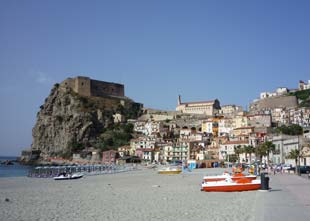
Scilla (pronounced sheella) is a stunningly-located fishing village in the Calabria region, in the south of Italy, on the toe of Italy’s boot. A rocky spur topped with an ancient fortress separates two narrow strips of seashore hemmed in by steep hillsides. Scilla is squeezed into this restricted and picturesque landscape and it is an unforgettable sight.
Scilla is straight out of myths; it is traditionally the home of the fearsome monster Scylla who, along with Charybdis (over the sea towards Sicily) guarded the narrow Strait of Messina and menaced Odysseus / Ulysses as he sailed by. According to the town’s tourist information leaflet “the origins of the castle date back to Ulysses”. Even if you don’t believe the mythological connections, the geography of Scilla’s castle on a commanding outcrop guarding the entrance to this important shipping route must have made it an important site for millennia.
Today Scilla is a pretty little town where visitors can relax on the beach, visit the castle or wander through the old fishing settlement taking photographs.
Scilla tourist information
Scilla is a town of three parts: the beach resort of Marina Grande, the castle and administrative centre of town, San Giorgio, on the higher ground behind, and the fishermen’s district, Chianalea.
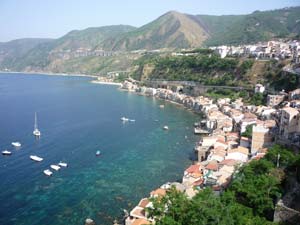 If you are arriving by train, the first part of Scilla you will see is Marina Grande, a long thin settlement which runs along Scilla’s pleasant beach. This part of town is fairly modern, with a cheerful seaside atmosphere and a choice of bars and restaurants. One of the most colourful of these is the Dali City Bar, by the castle outcrop, which is decorated in tribute to the Beatles. In the height of summer, Scilla becomes busy with seaside holidaymakers and day-trippers.
If you are arriving by train, the first part of Scilla you will see is Marina Grande, a long thin settlement which runs along Scilla’s pleasant beach. This part of town is fairly modern, with a cheerful seaside atmosphere and a choice of bars and restaurants. One of the most colourful of these is the Dali City Bar, by the castle outcrop, which is decorated in tribute to the Beatles. In the height of summer, Scilla becomes busy with seaside holidaymakers and day-trippers.
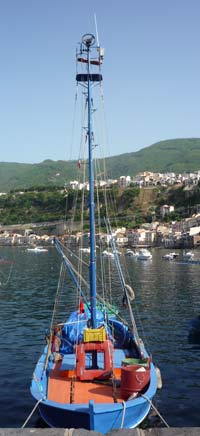
Ascending a flight of steps or the winding road up towards the castle promontory, you reach the ‘middle’ part of Scilla. Called San Giorgio, this urban area spreads out on a plateau above sea level. A restaurant on the cliff edge here, appropriately called Vertigine, is one of the most scenic places to eat in town.
Scilla’s fortress, the Castello Ruffo, is open to the public (there’s a small admission fee). Various parts of the old fortifications can be explored, and some exposed ruins give an idea of the history which must lie beneath the walls and foundations of today’s castle. At various times this spot has been a fortress, a home, a lighthouse, a monastery and a youth hostel. From the castle there are views of Sicily, the Calabrian coast and – on a clear day – of the Aeolian Islands. The castle sometimes hosts exhibitions, and it is home to the only remaining luntre, a traditional local boat used for fishing for swordfish (read on to learn more about this important activity).
Chianalea, nestled into a narrow strip of land to the east of the headland, is an ancient fishermen’s settlement with an atmosphere all of its own. The cramped houses here are built right against the sea, with waves washing up to their walls and with little fishing boats drawn up on tiny slipways. When we visited there was a lot of work going on to ‘smarten’ the area – hopefully not too much to detract from the historic charm. There are one or two little B&Bs, shops and places to eat and drink but not too touristy an atmosphere. Underwear and strips of orange peel are hung outside to dry and elderly residents sit comfortably inside their open doorways. Chianalea is listed as one of the ‘Borghi più belli d’Italia’ – ‘most beautiful villages in Italy’. Squeezed between the waves and the main road below the cliffs, it’s a small place with only one principal lane running its length, but you can while away time on a cafe terrace over the water, or by strolling out to see the boats in the harbour below the castle.
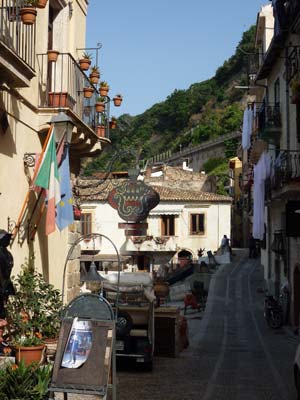
To avoid climbing back up and over the castle promontory, take a more level alternative route back to Marina Grande: the road which runs around the foot of the castle rock, on the seaward side.
Swordfish
Scilla is proud of its fishing heritage, specialising in catching swordfish (pesce spada). In the harbour you can see the fishing boats which hasten out to sea when swordfish are spotted; distinctive vessels called passarelle with tall watchtowers where a lookout can track the fish. If you are lucky you may see the fleet arriving back in Scilla with their catch. You’ll see the swordfish motif around town (even as a decorative feature of the the town railings) and in the local tourist literature you can read interesting stories of the fishing techniques and traditions. Swordfish is naturally the top dish in the local restaurants.
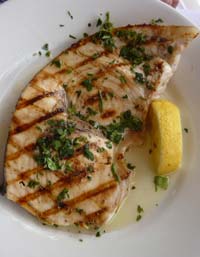
Travel and transport
Scilla is very conveniently on the railway line which travels south down Italy’s Tyrrhenian coast to Reggio di Calabria. Even more handily, Scilla station is just a few yards away from the seafront, making it easy to arrive and explore the town by public transport (although it would be a good idea to arrange a lift if you are staying in Chianalea and have heavy luggage). The facilities at the station are limited so it would be a good idea to acquire in advance the tickets you need for the next stage of your journey. According to the Trenitalia website, you can buy tickets in Scilla at the Polifemo cafe at Via Nazionale 63 and Imbesi Viaggi on Via Umberto.
The SS18 coastal road runs through Scilla just behind the settlement; a modern autostrada (the Salerno – Reggio di Calabria A3) passes close by with an exit for Scilla.
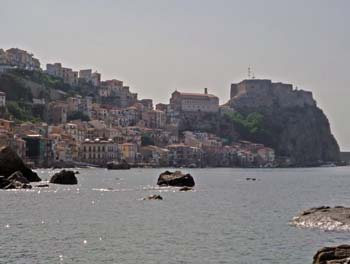
Around Scilla
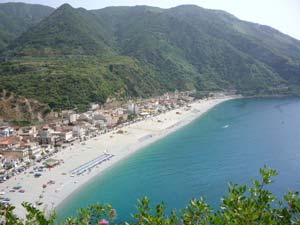
Scilla is on the coast between Reggio di Calabria and the Costa degli Dei (‘Coast of the Gods’), a lovely stretch of coastline dotted with resorts including Tropea. The railway line makes it easy to combine Scilla with holiday destinations in either of these directions, or with onward travel to Sicily from Villa San Giovanni or Reggio. There are several train services per day to Tropea and the journey takes around an hour and a half (sometimes with a change at Rosarno), while Reggio di Calabria is just half an hour away.
To the north of Scilla are a number of other resorts along a coast known as the Costa Viola (‘Violet’ or ‘Purple Coast’), including Palmi and Bagnara.
Accommodation
Most tourists will probably visit Scilla for a day trip, but there are several appealing accommodation options in Chianalea and by the beach if you fancy an overnight stay in these low-key and picturesque surroundings. These include the waterside Guest House Il Soffio di Eolo, seaview holiday apartments at Casa Vela B&B and historic four-star Hotel Palazzo Krataiis.
> Find available accommodation in Scilla
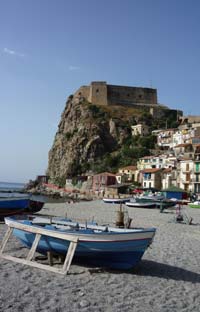
On this site
South to Calabria: a travel itinerary
Villa Antica Tropea – Tropea hotel review
Useful external links